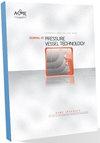基于卷积神经网络的电熔接头相控阵超声检测图像缺陷识别模型
IF 1.4
4区 工程技术
Q4 ENGINEERING, MECHANICAL
Journal of Pressure Vessel Technology-Transactions of the Asme
Pub Date : 2023-02-22
DOI:10.1115/1.4056836
引用次数: 0
摘要
摘要提出了一种缺陷识别模型,用于识别电熔(EF)接头相控阵超声检测(PA-UT)图像中的四种典型缺陷。经实践证明,PA-UT是检测聚乙烯管道EF接头缺陷最可行的方法。PA-UT图像的缺陷识别依赖于操作人员的经验,导致缺陷检出率不一致,识别速度较慢。该识别模型由异常检测模型和缺陷检测模型组成。该异常检测模型对PA-UT图像中的异常进行了识别,满足了实际检测实时识别的要求。缺陷检测模型对PA-UT异常图像中的缺陷进行分类定位,实现了较高的缺陷识别精度。通过比较检测模型、优化参数和扩充数据集,异常检测模型和缺陷检测模型达到了精度和速度的良好结合。本文章由计算机程序翻译,如有差异,请以英文原文为准。
Convolutional Neural Network Based Defect Recognition Model for Phased Array Ultrasonic Testing Images of Electrofusion Joints
Abstract This technical brief proposes a defect recognition model to recognize four typical defects of phased array ultrasonic testing (PA-UT) images for electrofusion (EF) joints. PA-UT has been proved to be the most feasible way to inspect defects in EF joints of polyethylene pipes. The recognition of defects in PA-UT images relies on the experience of operators, resulting in inconsistent defective detection rate and low recognition speed. The proposed recognition model was composed of an anomaly detection model and a defect detection model. The anomaly detection model recognized anomalies in PA-UT images, meeting the requirement of real-time recognition for practical inspection. The defect detection model classified and located defects in abnormal PA-UT images, achieving high accuracy of defects recognition. By comparing detection models, optimizing parameters and augmenting dataset, the anomaly detection model and defect detection model reached a good combination of accuracy and speed.
求助全文
通过发布文献求助,成功后即可免费获取论文全文。
去求助
来源期刊
CiteScore
2.10
自引率
10.00%
发文量
77
审稿时长
4.2 months
期刊介绍:
The Journal of Pressure Vessel Technology is the premier publication for the highest-quality research and interpretive reports on the design, analysis, materials, fabrication, construction, inspection, operation, and failure prevention of pressure vessels, piping, pipelines, power and heating boilers, heat exchangers, reaction vessels, pumps, valves, and other pressure and temperature-bearing components, as well as the nondestructive evaluation of critical components in mechanical engineering applications. Not only does the Journal cover all topics dealing with the design and analysis of pressure vessels, piping, and components, but it also contains discussions of their related codes and standards.
Applicable pressure technology areas of interest include: Dynamic and seismic analysis; Equipment qualification; Fabrication; Welding processes and integrity; Operation of vessels and piping; Fatigue and fracture prediction; Finite and boundary element methods; Fluid-structure interaction; High pressure engineering; Elevated temperature analysis and design; Inelastic analysis; Life extension; Lifeline earthquake engineering; PVP materials and their property databases; NDE; safety and reliability; Verification and qualification of software.

 求助内容:
求助内容: 应助结果提醒方式:
应助结果提醒方式:


